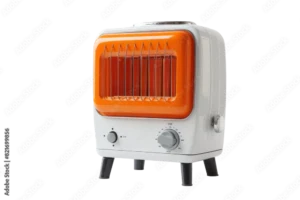 :
:
When temperatures drop, space heaters become a go-to solution for keeping warm, particularly in smaller spaces. But if you’ve been browsing for one, you’ve probably noticed terms like “ceramic” and “convection” popping up repeatedly. These two options are some of the most common types of electric space heaters, but what’s the difference? And which one is right for you?
If you’re an eco-conscious consumer aiming to save energy, or an urban millennial looking for a safe, efficient way to heat your space, read on to learn more. This guide will explain the differences, outline the pros and cons, and help you choose a heater that aligns with your sustainability goals and lifestyle needs.
The Basics of Ceramic and Convection Space Heaters
Ceramic Space Heaters
Ceramic space heaters use a heating element made of ceramic plates that are attached to metal coils. When electricity passes through the coils, the ceramic plates absorb the heat and release it into the surrounding air. Most ceramic heaters come with a fan to help distribute the warmth evenly.
Ceramic heaters are particularly popular because they heat up quickly and provide targeted warmth, making them ideal for smaller, enclosed spaces.
Best For:
- Personal spaces like bedrooms or home offices.
- Quick, focused heating.
Convection Space Heaters
Convection heaters work by warming the air surrounding the unit. They rely on natural air circulation or a fan to spread heat evenly throughout a room. Unlike ceramic heaters, which focus on targeted heating, convection heaters are better for warming up larger areas over an extended period.
Best For:
- Heating medium to large spaces.
- Maintaining a consistent temperature.
Pros and Cons of Ceramic Space Heaters
Pros:
- Energy Efficiency
Ceramic heaters warm up quickly and use less energy, making them a great choice for eco-conscious consumers focused on sustainable living.
- Compact and Portable
Their lightweight and compact designs make them ideal for urban dwellers in small apartments.
- Safety Features
Most ceramic heaters come equipped with auto-shutoff and tip-over protection, ensuring heating safety.
- Affordable
Ceramic heaters are widely available and are often more cost-effective.
Cons:
- Limited Reach
These heaters are better suited for small spaces and may struggle to heat a larger area effectively.
- Fan Noise
Some models with built-in fans can be noisy, which might disturb light sleepers.
Pros and Cons of Convection Space Heaters
Pros:
- Even Heating
Convection heaters distribute heat more evenly, making them ideal for larger spaces or shared rooms.
- Quieter Operation
Since many convection heaters don’t require a fan, they offer a quieter heating option.
- Long-lasting Warmth
Once the air is heated, it retains the warmth for longer periods, reducing the need for constant operation.
Cons:
- Slower Heat-Up Time
Convection heaters typically take longer to warm up compared to ceramic heaters.
- Size
They’re often larger and heavier, which can be a drawback if you need something portable.
- Energy Usage
Because they heat more air, convection heaters may use more electricity, depending on your settings.
How to Choose the Right Heater for You
When debating “ceramic vs. convection space heaters,” the best choice ultimately depends on your individual needs and priorities. Here are a few factors to consider when making your decision:
1. Space Size:
If you’re looking to heat a small room or focus on a personal area, a ceramic heater might work better for you. However, for larger rooms or shared spaces, convection heaters are more effective.
2. Energy Efficiency:
Eco-conscious consumers aiming for urban sustainability will appreciate that ceramic heaters are generally more energy-efficient for smaller, targeted heating tasks. However, convection heaters may save energy if used appropriately in larger spaces over longer periods.
3. Safety:
For households with kids or pets, heating safety is a top priority. Look for features like overheat protection and tip-over shutoff in either type of heater to minimize risks.
4. Budget:
Ceramic heaters are often more affordable upfront, whereas convection heaters might have a slightly higher price tag but could be more suitable for specific needs.
5. Noise Preference:
If you’re choosing a heater for a quiet area like a bedroom or a library, opt for a convection heater without a fan. For quick heat in noisier areas, a ceramic fan heater works just fine.
Final Thoughts on Sustainable Heating
Choosing between a ceramic and convection space heater doesn’t have to be complicated. Both options have their strengths, and the right pick depends on factors like the size of your space, your lifestyle, and your commitment to sustainable living.
If you’re still unsure, remember that ceramic heaters are great for fast, focused heat in smaller spaces, while convection heaters are perfect for warming larger rooms evenly. Whichever you choose, look for energy-efficient appliances with built-in safety features to align with your eco-friendly goals.
Staying warm doesn’t have to come at the expense of the planet—or your comfort. Upgrade your heating setup with a smart, sustainable choice today!
For more eco-friendly tips and insights into urban sustainability, stay tuned to our blog, and start heating smarter.
For Tons of Great Free Information please hit “Like & Subscribe”
Websiteconstructionconsumeradvocacyinstitute.com
Podcastanchor.fm/galloway




